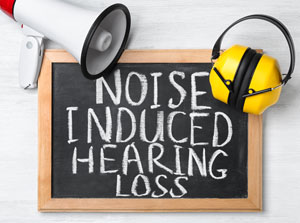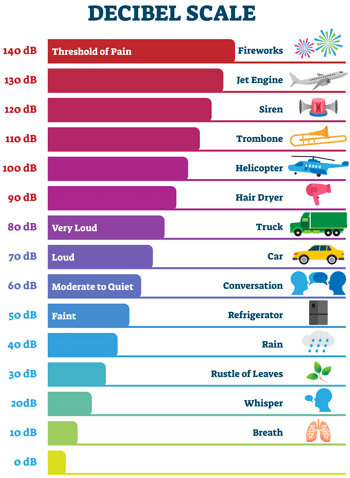Noise-Induced Hearing Loss: North Dakota's Silent Enemy
by Kirsten Bokinskie
November 2021
From firing a rifle, to pumping up headphone volume, to snow-blowing the driveway, or working on an oil rig, these activities have one thing in common. They are loud. So loud that, in fact, these noises can cause permanent hearing loss. A Centers for Disease Control and Prevention survey from within the last decade revealed that 1 in 5 adults in North Dakota self-reported some degree of hearing loss. The survey also compared hearing loss between states, and only six states had more people report hearing loss than North Dakota. Changing these facts for North Dakotans will involve understanding how loud is too loud and how to protect hearing when the 'too loud' cannot be avoided.
 Healthcare
professionals label hearing loss caused by exposure to
loud noise exactly that: noise-induced hearing loss, or
NIHL. According to the American Speech-Language-Hearing
Association (ASHA), NIHL can be caused by exposure to
a one-time intense sound at 140 decibels (dB) or greater,
the equivalent sound intensity of a .22 caliber rifle
shot. In contrast to a single loud exposure, NIHL can
also be caused by continuous exposure to sounds at 85 dB
or louder associated with everyday noises like a kitchen
garbage disposal, lawn mower, or busy restaurant. Other
common noise levels linked to daily recreational and
work-related activities cross that 85 dB threshold. For
example, playing music in headphones at maximum volume or
attending an outdoor sporting event. Common in North
Dakota are the sound of snowblowers at about 100 dB or
operating heavy machinery with noise levels reaching 120
dB or louder. Pistols and large-caliber rifles top off at
up to 175 dB, a fact perhaps the state's hunters already
know.
Healthcare
professionals label hearing loss caused by exposure to
loud noise exactly that: noise-induced hearing loss, or
NIHL. According to the American Speech-Language-Hearing
Association (ASHA), NIHL can be caused by exposure to
a one-time intense sound at 140 decibels (dB) or greater,
the equivalent sound intensity of a .22 caliber rifle
shot. In contrast to a single loud exposure, NIHL can
also be caused by continuous exposure to sounds at 85 dB
or louder associated with everyday noises like a kitchen
garbage disposal, lawn mower, or busy restaurant. Other
common noise levels linked to daily recreational and
work-related activities cross that 85 dB threshold. For
example, playing music in headphones at maximum volume or
attending an outdoor sporting event. Common in North
Dakota are the sound of snowblowers at about 100 dB or
operating heavy machinery with noise levels reaching 120
dB or louder. Pistols and large-caliber rifles top off at
up to 175 dB, a fact perhaps the state's hunters already
know.
Two more important facts about NIHL: It is sneaky, and it often occurs well before a person realizes it. Although hearing loss happens through a complex pathway, the basic injury is simple to understand. The hearing cells of the body, called hair cells, are found in the inner ear. They translate sound waves into signals for the brain to be able to "hear" sound. If sound waves move these hair cells with too much force, the cells die. When they die, these cells cannot be replaced, causing hearing loss that cannot be recovered. When continuous loud noises are combined with single noise exposures, hair cell death adds up and hearing worsens. The cumulative effect of exposure can be so gradual that the hearing loss is unrecognized by the individual or regarded as a normal consequence of aging. But family and friends often know it is happening. They may complain that their loved one has the TV volume too high, or they must speak in a very loud voice for normal conversation. Ultimately, total deafness can occur.
 Knowing how NIHL happens provides the wisdom for
preventing it. The first of three steps for prevention is
to understand that if hearing is not protected, it will
be lost. Second is to know how loud is too loud. Noise
levels are easy to measure with free decibel meter apps
on smart phones and other devices. Household appliances,
toys, and power tools come with noise ratings to help
consumers make smart decisions about their noise exposure
and protecting their hearing.
Knowing how NIHL happens provides the wisdom for
preventing it. The first of three steps for prevention is
to understand that if hearing is not protected, it will
be lost. Second is to know how loud is too loud. Noise
levels are easy to measure with free decibel meter apps
on smart phones and other devices. Household appliances,
toys, and power tools come with noise ratings to help
consumers make smart decisions about their noise exposure
and protecting their hearing.
The third step of NIHL prevention is to control volume when possible, and when it's impossible, use appropriate hearing protection. Start by turning down the volume on headphones, setting volume limits on devices used by children, and trying to avoid situations involving loud noises. If loud noise exposure cannot be prevented, use protective devices like ear plugs and earmuffs which are typically inexpensive and can be found in most farm supply and sporting goods stores. Used by themselves, these devices can reduce noise by 15 to 30 dB. ASHA recommends using both ear plugs and earmuffs if noise levels will be above 105 dB for more than eight hours or for a single impulse above 140 dB.
The North Dakota School for the Deaf/Resource Center for Deaf and Hard of Hearing is the organization responsible for providing resources and services related to hearing for the state. Their website has links to more information on hearing loss and where to find local healthcare professionals. While noisy activities may be part of a routine workday, completing household chores, or a way to relax, permanent hearing loss does not have to be the end result.
This article also appeared in the November 24, 2021 issue of the Dickinson Press.
About the Author
 Kirsten Bokinskie is a third-year medical
student at the University of North Dakota School of
Medicine & Health Sciences. She was selected as the
Dickinson participant for the school's ROME program, or
Rural Opportunities in Medical Education. The program
includes teaching student doctors the importance of rural
newspapers. As a future rural healthcare leader,
Bokinskie has written this column to provide health
information for her ROME community. The information is
not for diagnosis or treatment and should not be used in
place of previous medical advice provided by a licensed
practitioner.-
Kirsten Bokinskie is a third-year medical
student at the University of North Dakota School of
Medicine & Health Sciences. She was selected as the
Dickinson participant for the school's ROME program, or
Rural Opportunities in Medical Education. The program
includes teaching student doctors the importance of rural
newspapers. As a future rural healthcare leader,
Bokinskie has written this column to provide health
information for her ROME community. The information is
not for diagnosis or treatment and should not be used in
place of previous medical advice provided by a licensed
practitioner.-
